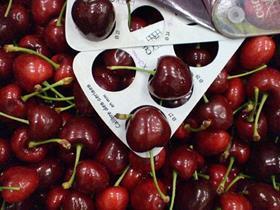
The landing may not have been so hard as that seen in China, but Taiwan's cherry market has also taken a tumble with an influx of Chilean fruit over the past week.
The first air-shipments of Chilean cherries arrived in Taiwan in late November, a few days later than arrivals into China. Opening prices did not hit the dizzy heights witnessed in China, with a ceiling CIF price of around US$90 per 5kg carton, according to importers – and this factor helps to explain why the subsequent slump in prices has not been so dramatic.
'The week before last, big volumes of Chilean cherries began to arrive and the market price dropped very fast,' explained Eason Chi of major Taiwanese importer Coverings International.
Speaking on yesterday (Monday), he told Fruitnet.com that importers were making losses on anything other than large-sized, good-quality cherries.
'Only large-sized fruit in good condition can fetch US$67 per carton now, and even this price level only amounts to a limited profit,' he said. 'We will lose money on the other sizes, not to mention the bad quality ones.'
Hopes of a rally in market prices over the weekend, which coincided with a monthly prayer day, failed to eventuate.
Mr Chi added that the lack of direct airline services from Chile to Taiwan has also resulted in holds-up and disrupted sales. 'One of the disadvantages of airfreighting cherries from Chile is it takes too many transfer flights,' he noted. 'Our cargo often faces three-day delays. Sometimes it'll miss the selling time for key vacation periods or arrive with poor quality as a result.'
Cherries are not the only fruit from Chile to face an oversupply issue in Taiwan over recent months, according to Mr Chi, who notes that little imported fruit on the market has been making companies money of late.
'Usually we can earn from Chilean Fuji, but this year the market has been flooded with almost double the volume imported last year `2,500 containers compared to 1,500 containers`. We’ve all lost a lot of money because prices are so low,' he told Fruitnet.com.
The Chilean Fuji glut, which importers blame on misleading information from Chilean exporters following the earthquake there earlier this year, cut Washington apple imports by half this year compared to last, according to Mr Chi.
And while Chilean and Peruvian grape exporters reported record export volumes sent to Taiwan during 2009/10, importers claim the lion’s share was diverted to China. “Chilean and Peruvian grape exporters base their grape export figures on the number of phytosanitary certificates they apply for, but a lot of fruit for Taiwan ends up being diverted to China, or Hong Kong,” pointed out Coverings’ Norman Tarng. “This is a growing trend.”
According to Mr Chi, 80 per cent of most fruit imported into Taiwan is redirected by Taiwanese importers to China (the top quality) and the remaining mid-range products are kept for Taiwan. “We can get the highest profits with this strategy,” he said. “It’s not a new strategy, but Taiwanese importers are increasingly setting up offices in China or partnerships with importers in China.”



